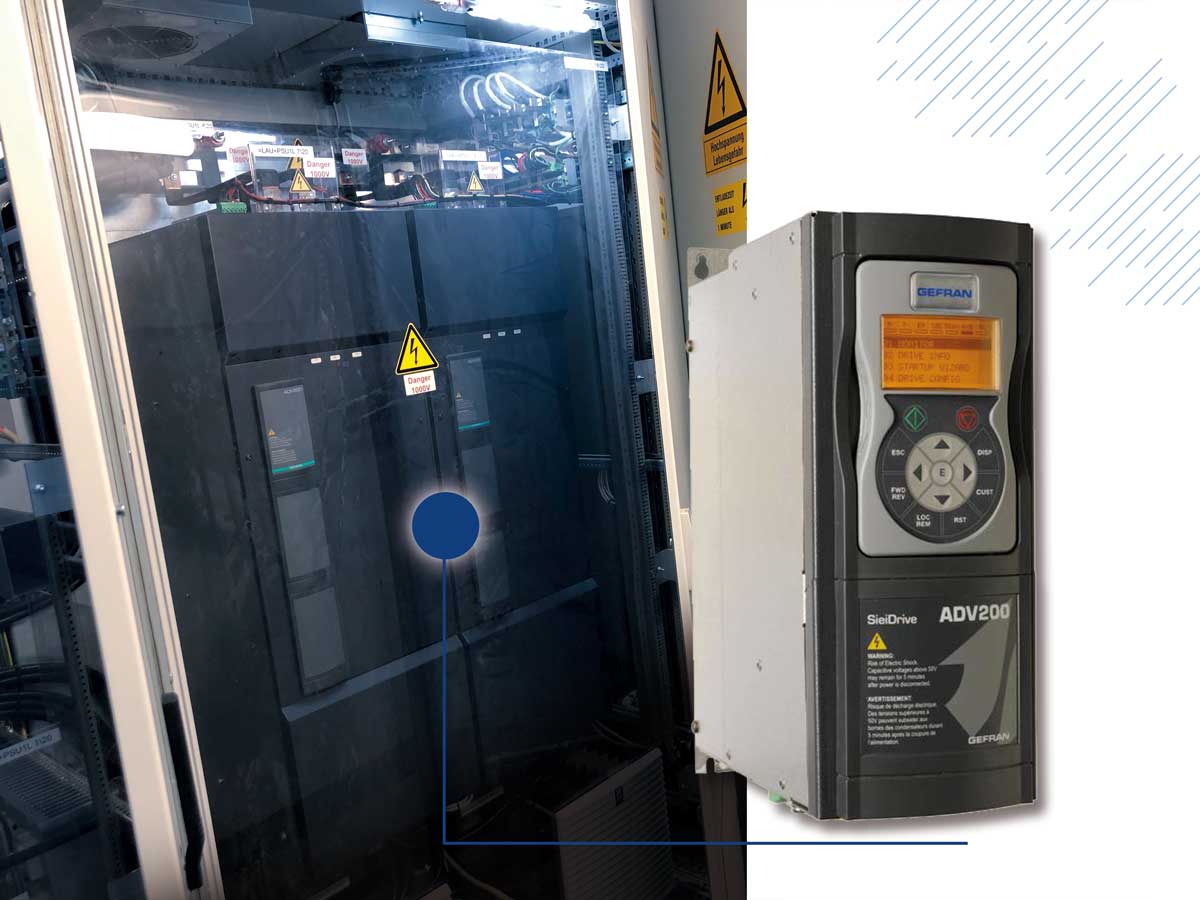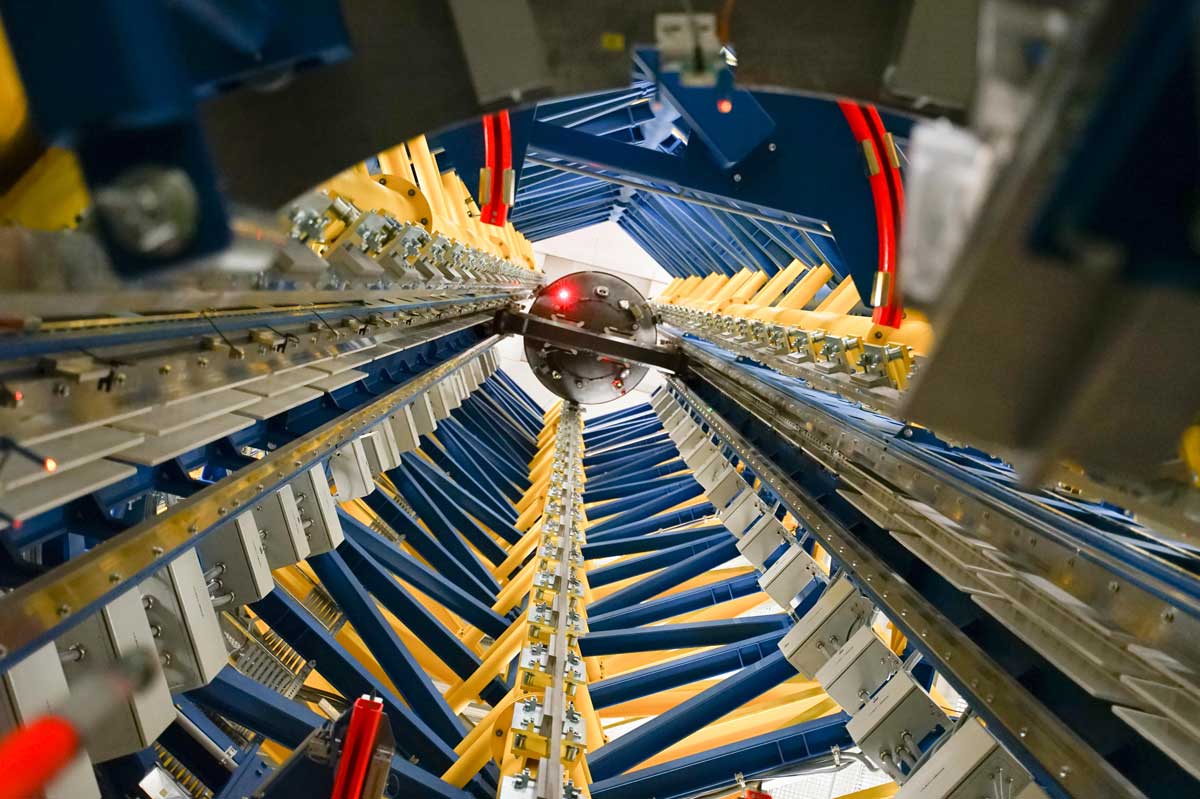A Drop Tower of Superlatives
Nov 1, 2020

GEFRAN frequency converters were installed in Hanover, Germany’s unique Einstein Elevator.
by Giuseppe Savoca
Physical and production engineering experiments for applications in space, on the moon or even on Mars: what sounds like science fiction could soon become reality. Research experiments to this end are already taking place in a new free drop tower at Leibniz University Hannover. This is the Einstein Elevator,[1-2] where variable gravitational conditions with up to 4 s of weightlessness can be set. The test capsule in the tower is accelerated by a high-power drive system with a power requirement of several megawatts. GEFRAN manufactured its frequency converters that control its power supply.
The moon is an ideal starting point for expeditions and may even serve as a research station in the future. Manned space flight, therefore, requires ever more equipment that can be used to produce construction material or for manufacturing components and spare parts. Researchers from Laser Zentrum Hannover e.V. and the IRAS Institute for Space Flight Systems of the Technical University of Braunschweig, both in Germany, are currently working on the MOONRISE project (see sidebar) to develop a laser that can melt moon dust and form it into solid balls. “That is the first step for bringing 3D printing to the moon in the future,” says Dr. Ludger Overmeyer, who serves as director of the Institute for Transport Automation Technology (ITA) at Leibniz, chairman of the board of research at Laser Zentrum Hannover and manager of the MOONRISE project.
“Production or processing steps in this environment take place under completely different gravitational conditions than on the Earth,” Overmeyer explains. To simulate ambient conditions in space, the ITA, in cooperation with the Institute for Quantum Optics at Leibniz, initiated the project a few years ago, and it was put into operation at the start of this year.
Three, Two, One, Launch!
While the repeat rate for other drop towers is only two to three experiments per day, a new test can be started in the Einstein Elevator every 4 min, for a theoretical total of 300 flights per day in three-shift operation. Instead of large vacuum chambers and a freefall, as in other towers, a test chamber — in the form of a gondola guided on rails — moves up and down at tremendous speeds. The Einstein Elevator is also the first tower in the world that can simulate different gravitational conditions, in addition to weightlessness. With a diameter of 1.7 m, a height of 2 m and a maximum capacity of 1000 kg, the gondola is big enough for experimental setups.
“The Einstein Elevator is a masterpiece of interdisciplinary engineering that combines the drive technology from roller coasters with the positioning accuracy of a machining center,” explains Overmeyer. The challenge consists of moving heavy loads at very high speeds and braking with absolute precision. The motors must deliver tremendous power, and there must be a high level of automation. The system must also be equipped with extremely precise measuring and control technology.
The converters are also extremely important for synchronization. The system contains three independent drivetrains. Two of them are used to accelerate the gondola. “Each drive train is equipped with five GEFRAN ADV200 series[3] frequency converters connected in parallel. Each has a capacity of 400 kW, plus an overload of up to 180% to move the system upward with a high level of symmetry,” explains Christoph Lotz, project manager for the Einstein Elevator at ITA. The third drive train controls the hovering height (weightlessness) and generates the variable accelerations.


High-Power Drive System
The advanced drive, brake and control system for operation of the Einstein Elevator (including the hovering technology) was developed by INTRASYS GmbH[4] in cooperation with Leibniz University Hannover. This allows vertical acceleration of the gondola, which weighs more than 1 mT, with a force of 5 G to 72 km/h in 0.5 s, as well as safe braking afterward. To achieve this, the linear drive systems provided by the company require very high currents for a few seconds. “When the gondola shoots up, the GEFRAN converters draw a huge amount of power from the supercapacitor battery (SC) energy storage system from STERCOM GmbH[5] and supply it to the stators,” Dr. Tobias Hollmer, managing director of R&D at INTRASYS, explains. In the stators, the current creates a magnetic field that interacts with another magnetic field to drive the vehicle.
The Einstein Elevator uses both standard and specialized components that were specially developed by the drive manufacturer for the drop tower. “As opposed to our time-proven rollercoaster drives, we had to implement a much more precise positioning system for this project,” says Hollmer. “That was necessary in order to meet the system’s stringent requirements for control accuracy.” Due to the dynamics of the application, the company also uses a new method for optical data transmission, since there was no ready solution on the market.
MOONRISE: Bringing 3D Printing to the Moon
The MOONRISE project was started to develop a laser system to melt the lunar regolith on the moon’s surface. This is the first step in bringing additive manufacturing, or 3D printing, to the moon. The laser system was tested under simulated moon conditions in the Einstein Elevator at the beginning of the year. This unprecedented experiment was conducted by Laser Zentrum Hannover e.V. in cooperation with the IRAS Institute for Space Flight Systems of the Technical University of Braunschweig in the Hannover Institute of Technology’s Einstein Elevator at Leibniz University Hannover. This ambitious and pioneering research project is funded by the Volkswagen Foundation within the framework of “Open — for the Extraordinary.” The underlying concept of the project and its current progress are presented in the “MOONRISE” video.
Measurement and Control
Another decisive aspect is the seamless interplay between the control and measuring technology. “Our sensors are mounted directly on the gondola and send data in real time to the drive system, which is installed in the tower,” explains Lotz. “That was a challenge, considering that it has to function properly not only at high speeds, but also over such a long path in the 40-m-high drop tower.”
To achieve precise hovering control, INTRASYS also developed a new control system and a specially designed magnetic yoke that substantially reduces the weight compared to that of standard yokes. Hollmer says:
“With this system, we are definitely treading new ground technologically. From my point of view, the combination of such high drive power of up to 5 MW and high-precision control — which makes it possible to keep the hovering height within the gondola constant within a few millimeters — is especially impressive.”
High-Power Storage System
When it became apparent during the planning of the drop tower that such high power for the drive could not simply be drawn from the mains, STERCOM, which specializes in the construction of high-power storage systems, was consulted. “If we had simply connected the GEFRAN converters to the mains so they convert AC voltage to DC, that would put a tremendous load on the supply network, causing the voltage in the sensitive research facilities in the vicinity to collapse,” explains Robert Sterff, CEO and founder of STERCOM. “The power needed in the Einstein Elevator requires the use of high-power buffer storage that is charged slowly but can deliver very high currents — up to 7000 A — quickly.”
While other applications use recovery systems for storage and reuse of the braking energy, the ITA decided against regenerative braking. The power saved is in no way proportional to the safety risk. “Our priority was to be able to stop the system safely at all times,” says Overmeyer. After the power in a given experiment is used up, the system has 4 min to recharge. With about 1 million charge cycles, an SC has a much longer life then a normal battery, which is limited to only a few thousand cycles. The storage elements used are double-layer capacitors or SCs, which are high-performance capacitors with large capacities. Although they store less energy than modern lithium batteries, they can release it much quicker and more times. “Conventional batteries are like endurance athletes, while SCs are like sprinters with a lot of take-off power,” Sterff explains.


Further Development Planned
The researchers at Leibniz University Hannover are very satisfied with the interplay of the chosen drive components and the interdisciplinary cooperation between the project partners. “Development of the system will continue, with new experiments to be conducted in the near future,” says Overmeyer. In cooperation with the ITA research team, INTRASYS will create additional operating profiles for an even broader test spectrum for the Einstein Elevator for the stimulation of different, detailed gravitational, atmospheric and ambient conditions. “Above all, special details in the control engineering must be implemented,” says Lotz. This will allow the research to approach the goal of implementing the necessary production or processing steps for a functioning infrastructure in space, on the moon or on other planets.

GEFRAN Converter Technology
For the Einstein Elevator, GEFRAN supplied INTRASYS with frequency converters equipped with a special control software to control the drives. To move the gondola test chamber, the converter technology supplies the linear motors with electricity from an energy storage system connected by means of a DC link. The GEFRAN components were designed for high robustness and durability. The company previously implemented numerous converter concepts for applications in harsh environments, such as metal machining or plastics. In addition to standard converters and software, the company also develops custom solutions and entire control cabinet solutions. STERCOM and GEFRAN, a longstanding INTRASYS supplier, have implemented many drive solutions for roller coasters and passenger conveyance systems.
References
[1] www.hitec.uni-hannover.de/de/grossgeraete/einstein-elevator
[2] www.elevatorworld.com/einstein-elevator
[3] www.gefran.com/de/de/products/250-adv200-frequenzumrichter-mit-feldorientierter-vektorregelung-fuer-den-schaltschrankeinbau
[4] intrasys-gmbh.com
[5] stercom.de/de
[6] www.lzh.de/de
[7] www.gefran.com/de/de/applications/5-aufzugstechni
Get more of Elevator World. Sign up for our free e-newsletter.









